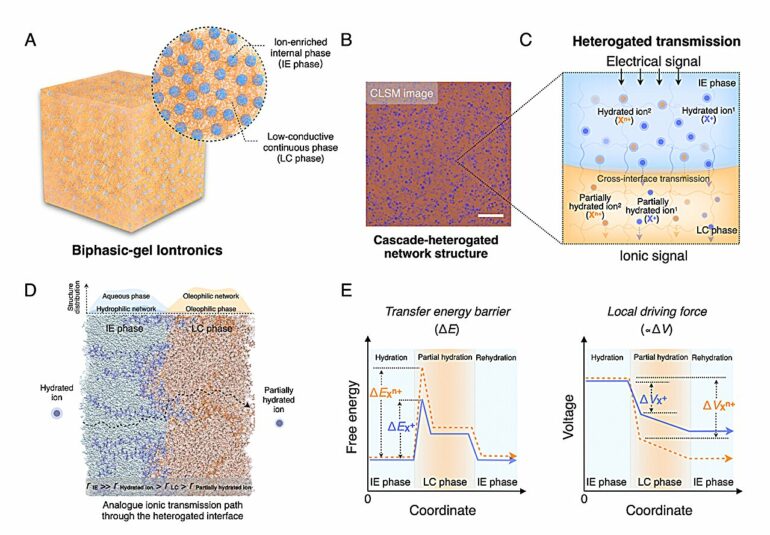In biological systems, complex neuronal networks with highly polarized synaptic gating interfaces are responsible for processing and transmitting intricate biosignals.
Inspired by neuronal interfacial biosignal-gating architectures, researchers led by Prof. Wen Liping from the Technical Institute of Physics and Chemistry of the Chinese Academy of Sciences, and Prof. Zhao Ziguang from the University of Chinese Academy of Sciences, together with their collaborators, have developed biphasic gel iontronics with cascaded heterointerface-gated properties to achieve versatile electronic-ionic signal transmission.
The study was published in Science on Nov. 2.
Electronic and iontronic devices have attracted considerable attention as they bridge the communication gap between abiotic and biotic interfaces, finding crucial applications in neural electrodes, neuroprosthetics, and smart implantable devices. However, due to monotonous and single electronic/ionic signals that cannot match more biocompatible information, state-of-the-art electronics and iontronics have been limited.
Sophisticated recognition and precise control of diverse bioionic signals in artificial devices for complex biological environments have thus remained a significant challenge.
In this study, by mimicking the hierarchical interfacial gating mechanisms of neural networks, the researchers developed cascade-heterogated biphasic gel (HBG) iontronics that facilitate diverse ionic cross-medium transmission.
The HBG materials, according to the researchers, were synthesized through a controlled liquid–liquid phase-separated polymerization strategy, integrating the ion-enriched internal phases with the low-conductivity continuous phase.
In the process of ionic transmission, the multiple heterointerfaces within the HBG materials played a critical role in determining the transfer free energy barriers experienced by ions and their hydration–dehydration states. This fundamentally amplified the differentiation in cross-interface transmission between different ions by several orders of magnitude.
In this way, multi-ionic hierarchical signal transmission, which is highly correlated with the hierarchical discrepancy of ionic transfer energy barriers, could be realized.
In addition, a chemically-enhanced HBG system derived from the synergistic combination of specific ligand groups was successfully constructed for selective ionic cross-stage signal transmission.
Using this system, the researchers achieved successful regulation of the cardiac electrical activity of bullfrog hearts by using various biofunctional neurohumoral ionic signals derived from the HBG-based ionic synapse.
By taking advantage of this novel ion-gating mechanism and the capacity for programmable ionic transmission, HBG iontronics can induce the conversion of electronic input signals into programmable bioionic signals to serve diverse biocommunication carriers. It is thus expected that HBG iontronics will be able to accelerate progress in a variety of biotechnological applications.
More information:
Weipeng Chen et al, Cascade-heterogated biphasic gel iontronics for electronic-to-multi-ionic signal transmission, Science (2023). DOI: 10.1126/science.adg0059
Provided by
Chinese Academy of Sciences
Citation:
Scientists develop new method for electronic-to-multi-ionic signal transmission (2023, November 7)



